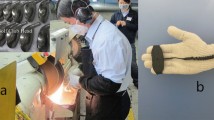Summary
An experimental study of the physiological effects of brush saw operation was performed on eight professional agricultural workers. The experiments were carried out in the field under practical working conditions. Aesthesiometric thresholds (two-point discrimination and depth sense perception), manipulative dexterity, pinch grip force and fingertip skin temperature (FST) were measured before and after exposure to different combinations of static load (handle holding), noise and vibration by using new production brush saws for 5 to 15 min. The changes in the peripheral circulatory, sensorineural and muscular functions of the brush saw workers were not found to be significantly different under the various exposure conditions. Static load accounted for the major part of the changes in aesthesiometric thresholds, pinch grip force and FST after brush saw operation. With respect to baseline measurements, no significant difference in manipulative skill was observed after each exposure period. The weighted vibration accelerations from the right and left handles of a brush saw were 3.13 and 1.80 m/s2, respectively. The assessment of brush saw vibration exposure according to ISO 5349 and the results of FST measurements were consistent with the findings of some epidemiological surveys indicating a low risk of vibration-induced white finger among brush sawyers. This investigation pointed out that the increase in the aesthesiometric thresholds was mainly determined by handle holding, and that the reduction in gripping force during actual work was related to the duration of brush saw operation. Therefore, prolonged static overload on the nerves, muscles and joints of the hand-arm system could explain the increased risk of musculoskeletal and sensorineural disorders found among brush saw users.
Similar content being viewed by others
References
Bjerker N, Kylin B, Lindström IG (1972) Changes in the vibratory sensation threshold after exposure to powerful vibration. Ergonomics 4:399–406
Bovenzi M (1987) Finger thermometry in the assessment of subjects with vibration-induced white finger. Scand J Work Environ Health 13:348–351
Bovenzi M, Zadini A (1989) Quantitative estimation of aesthesiometric thresholds for assessing impaired tactile sensation in workers exposed to vibration. Int Arch Occup Environ Health 61:431–435
Brammer AJ, Taylor W, Lundborg G (1987) Sensorineural stages of the hand-arm vibration syndrome. Scand J Work Environ Health 13:279–283
Carlson W, Samueloff S, Taylor W, Wasserman D (1979) Instrumentation of measurement of sensory loss in the fingertips. J Occup Med 21:260–264
Fessel WJ (1975) Rheumatology for clinicians. Stratton, New York
Futatsuka M (1979) A study on the vibration hazards due to using bush cutters. Jpn J Health 21:269–273
Futatsuka R (1984) Epidemiological studies of vibration disease due to brush saw operation. Int Arch Occup Environ Health 54:251–260
Futatsuka M, Yasutake N, Sakurai T, Matsumoto T (1985) Comparative study of vibration disease among operators of vibrating tools by factor analysis. Br J Med 42:260–266
Haines T, Chong J, Verrall AB, Julian J, Bernholz C, Spears R, Muir DCF (1988) Aesthesiometric threshold changes over the course of a workshift in miners exposed to hand-arm vibration. Br J Ind Med 45:106–111
Hasiguchi T, Sakakibara H, Yamada S (1989) Changes of skin blood flow in the fingers and dorsum of the foot in chain saw operation. In: Proc Fifth Int Conf on Hand-Arm Vibration. Kanazawa, Japan, p 34
Heslop J, Coggon D, Acheson ED (1983) The prevalence of intermittent digital ischaemia (Raynaud's phenomenon) in a general practice. J R Coll Gen Pract 33:85–89
Hisashige A, Kume I, Ogawa T, Taniguchi K, Nakagiri S, Aoyama H (1979) A study on vibration syndrome among bush cleaner operators. Jpn J Ind Health 21:683–684
International Organisation for Standardisation (1986) Forestry machinery — portable brush saws — measurement of hand-transmitted vibration. ISO/DIS 7916, Geneva
International Organisation for Standardisation (1986) Mechanical vibration — guidelines for the measurement and the assessment of human exposure to hand-transmitted vibration. ISO 5349, Geneva
International Section for Research of the International Social Security Association (1989) Vibration at work. Institut National de Recherche et de Sécurité (INRS), Paris
Itoh N, Kasamatsu T, Shiomi S, Iwata H (1978) Vibration disease due to grass cutters. Jpn J Ind Health 20:451–452
Maricq HR, Weinrich MC, Keil JE, LeRoy EC (1986) Prevalence of Raynaud phenomenon in the general population. A preliminary study by questionnaire. J Chron Dis 39:423–427
Miyakita T, Miura H, Futatsuka M (1987) An experimental study of the physiological effects of chain saw operation. Br J Ind Med 44:41–46
Nishiyama K, Watanabe S (1981) Temporary threshold shift of vibration sensation after clasping a vibrating handle. Int Arch Occup Environ Health 49:21–23
Schäfer N, Dupuis H, Hartung E (1984) Acute effects of shock-type vibration transmitted to the hand-arm system. Int Arch Occup Environ Health 55:49–59
Scheffer M, Dupuis H (1989) Effects of combined hand-arm vibration and cold skin temperature. Int Arch Occup Environ Health 61:375–378
Taylor W, Pelmear PL, Pearson JCG (1975) Vibration-induced white finger epidemiology. In: Taylor W, Pelmear PL (eds) Vibration white finger in industry. Academic Press, London, pp 1–13
Verberk MM, Sallé HJA, Kempers O (1985) Vibratory and tactile sense of the fingers after working with sanders. Int Arch Occup Environ Health 56:217–223
Wikström BO, Friberg M, Isaksson A (1988) Work load, vibration and noise exposure for lumberjacks. In: Proc United Kingdom and French joint meeting on human response to vibration, Vandoevre, France, pp 1–11
Author information
Authors and Affiliations
Rights and permissions
About this article
Cite this article
Bovenzi, M., Peretti, A., Zadini, A. et al. Physiological reactions during brush saw operation. Int. Arch Occup Environ Heath 62, 445–449 (1990). https://doi.org/10.1007/BF00379061
Received:
Accepted:
Issue Date:
DOI: https://doi.org/10.1007/BF00379061




